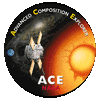

The origin of Cosmic Rays (CRs) is a fundamental and central challenge to astrophysics. ACE, with its collection of high resolution spectrometers, offers a unique opportunity to address questions related to the elemental, isotopic and ionic charge state composition of energetic nuclei from H to Zn (1 <= Z <= 30). In particular, the Solar Isotope Spectrometer (SIS) and the Cosmic Ray Isotope Spectrometer (CRIS) provide a combination of instrumentation that allows one to investigate basic questions of cosmic ray origin (both anomalous and galactic), CR transport and energization, and the composition of the interstellar medium. SIS and CRIS measure elemental and isotopic composition over an energy range that encompasses the full anomalous cosmic ray (ACR) spectrum as well as low-energy galactic cosmic rays (GCRs).
The work proposed has two goals, the second of which cannot be addressed without a thorough understanding of the first. These are to use ACE observations (specifically SIS and CRIS) (1) to study the modulation of anomalous and galactic CRs of all species by the solar wind, and (2) to investigate possible sites of anomalous and galactic CR acceleration. At the energies measured by SIS and CRIS, both ACRs and GCRs experience substantial solar modulation. Accordingly, before any meaningful study of possible sites of CR energization can be undertaken, the observed modulated spectra must be understood in terms of the source spectra. This proposal therefore offers a dual approach for using the SIS and CRIS observations to address questions of basic importance to CR physics. The modulation goals of this research program are
Two possible sites for the acceleration of CRs will be considered: the termination shock for the acceleration of ACRs and supernova shocks for the acceleration of GCRs. For ACRs accelerated at the termination shock, we shall
Our Email Address: asc@srl.caltech.edu